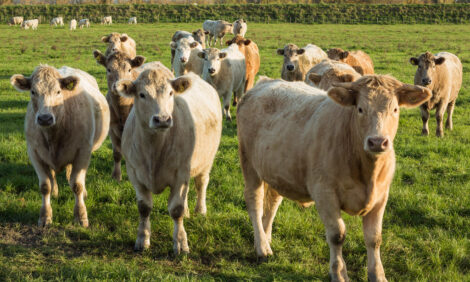



Let’s Talk, Cattle Feeder Says
US - Communication could help solve many challenges in the beef industry today. That’s what Tom Brink, senior vice president of Five Rivers Cattle Feeders, told producers at two seminars in November.The Feeding Quality Forums in Garden City, Kan., and South Sioux City, Neb., were cosponsored by Certified Angus Beef LLC (CAB)
“A lot of cattle out there are just genetically designed wrong,” Brink said. “Very simply, they’re not put together in a way that’s going to do what people need on through the production chain, or fit what the consumer needs.”
After initial comments about the basics of price risk management, Brink said genetics, health and use of appropriate feeding technologies could improve with more coordination among rancher, grower and feedlot.
* "Selection within those breeds can make them better in terms of feedlot performance and carcass genetics, as you put those pieces together." |
|
Tom Brink, senior vice president of Five Rivers Cattle Feeders.
|
“I encourage (cattle feeders) to keep that message going back to the people you’re buying cattle from,” he said. “Tell them what you want. Tell them what works. Like all large feeding operations, we feed all types of cattle, because that’s what the industry produces. But that does not make all cattle equally desirable.”
Five Rivers, the largest cattle feeding operation in the U.S., prefers cattle that are 50% to 75% Angus, with the balance being Continental breeds.
“Clearly, all the other rules of genetics still apply,” he said. “Selection within those breeds can make them better in terms of feedlot performance and carcass genetics, as you put those pieces together.”
He said it’s important to tell ranchers what their cattle do well, and how they could improve them to better fit the feeding and packing sectors.
“If we did nothing else in our industry, other than build a lot of cattle based on that balanced genetic input, our industry would get a lot better over night. It absolutely would,” he said. Another way to improve the feeding business is to work on health.
“Health is still the number one production problem that we face as cattle feeders,” Brink said. “That hasn’t changed.”
Five Rivers data, over a two-month period this fall, shows cattle with less than 1% death loss generated $28.80 profit per head. Those with more than 2% death loss dropped to $5.35 per head profit.
“That leaves less than a fifth of the profit,” he said. “What that challenges all of us to do is to discriminate hard against the high-risk cattle.”
Vaccinations and other health products have improved, yet there are still as many cattle getting sick. Brink suggests a new perspective.
“We have to start thinking of this problem as being rooted differently, in the structure of the industry and the lack of communication,” he said. “How are we going to address that?
“There’s only one way, and that is to work backward. Offer feedback. Tell the order buyers. Make them accountable when you have blow-ups. It takes all those things and a lot of energy and time,” Brink said.
Just as the ranchers need to know what works in feedlots and on the rail, feeders need to know what consumers want.
“It’s pretty simple. If you satisfy the consumer, you get beef demand growth,” he said. “If you think only internally and look only at your own needs, then you just kind of tread water at best.”
New performance enhancing technologies usually benefit early adopters the most, and then use expands when others see those advantages.
“Cattle feeders are in a very competitive business,” he explained. “Pretty soon, we all bid that increased performance – the economic advantage – right back into the price of feeder cattle. Most of the benefit is going to accrue to somebody else.”
When the technology does more than just increase performance, cattlemen need to look at the bigger picture.
“If certain new technologies negatively affect our end product, the entire story plays out differently. What happens from an overall industry standpoint, if enough of us use it, and it negatively impacts beef demand?” Brink asked.
“If beef demand declines, we have, in a very real sense, locked ourselves into a no-win situation,” he said. “The decline in beef demand could very easily be more than the productivity benefit of the technology.”
Through most of the 1990s, U.S. consumer expenditures on beef were relatively flat, but from 1999-2004, there was a 7% growth each year. Annual increases have continued most every year since then, including 2007, Brink said.
“We’re now matching our products better with consumer needs,” he said, noting the growth of branded beef programs during recent years. “A lot has changed as we’ve seen our top-line (price) grow so dramatically in the last 8 or 10 years. There’s more opportunity but also more at risk than ever before. Those are things to think about as you look at some of the new technology that’s available.”
Active communication will take that a step farther than just thinking, he added: “Learn what the next person on down the chain expects, and learn how to deliver it.”
To view a copy of Brink’s presentation, visit:
http://www.cabpartners.com/events/past_events/index.php
TheCattleSite News Desk


